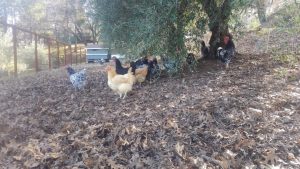Put your flock back to work!
This was a lesson I learned years ago when I first became interested in growing my own garden. At a potluck with friends in Oregon I was blown away by my friend’s tomatoes.
I asked her: “What’s your secret?”
“Chickens!” she said.
As it turned out, she was using a backyard-scale crop rotation that incorporated her laying hens, occasionally allowing them to graze her garden beds, add fertility, eat bugs, scratch up the soil, and eat seeds. I realized that this integration was something I needed to try myself.
My poultry experience began soon after, with a small flock of ducks that I allowed to graze around my yard and garden. They did a terrific job of controlling insects, snails, and slugs while keeping the lawn mowed and adding fertility.
A year later, I took a job working on a diverse farm in the Napa Valley of California. The farm had laying hens, vineyards, fruit and olive orchards, and a vegetable garden. It was an obvious next step to use the old laying hens, who were no longer productive, in the vineyards and orchards. This was a great way to utilize old birds that would otherwise be destined for the soup pot.
On the farm, we used a system of electric fencing and mobile coops to move the birds around from place to place. On a farm scale we were using tractors to pick up and move the coop, but there are several ways to accomplish this on a smaller scale:
1) If you have a permanent coop, you can simply create runs using portable fencing and move them when you feel the chickens have done their job.
2) Set up more permanent paddocks that can be opened and closed to allow the birds in and out as you feel necessary.
3) Build a mobile coop that can be moved from time to time. (There are so many ideas for mobile coops—I will let you read some of the other blogs on flock journey to help you decide what would be best for you.)
In a setting where you have established fruit trees, chickens are a natural fit. They are easy to integrate by simply allowing them access to the orchard. The trees provide a natural habitat with shade, branches to perch on, and protection form airborne predators. The poultry provide benefits to the orchard as well. They help with insect control, improve soil, and control some weeds. Ideally you should also plant an appropriate, multi species cover crop that will help improve your soil.
Row crops, on the other hand, need a bit more planning. You can use chickens to improve the soil either before you plant the crop, or after you harvest. You can also put the chickens directly into certain crops that are tolerant of their scratching and pecking. A backyard crop of sweet corn or popcorn provides an excellent place to graze your birds. Let your crop get to the point where it can provide your birds a bit of shade, typically July for most areas, position your coop near the crop, fence in the area (I like to use a electro net fencing to contain the birds, and provide some additional protection from predators), and if you want, throw out a bit of scratch or a few meal worms to encourage them to get out there and put some nitrogen down. You can leave them in the corn up to harvest and beyond!
Have fun with your flock and find a system that works for you.
Drew Erickson is Farm Manager for Rodale Institute Midwest Organic Center in Marion, Iowa. Learn more about Rodale Institute and their work in the Midwest at RodaleInstitute.org/Midwest.

Chickens in vineyards in Napa Valley (above) Chickens in corn in Iowa (below)

Chickens in olive orchard in napa valley (below)
